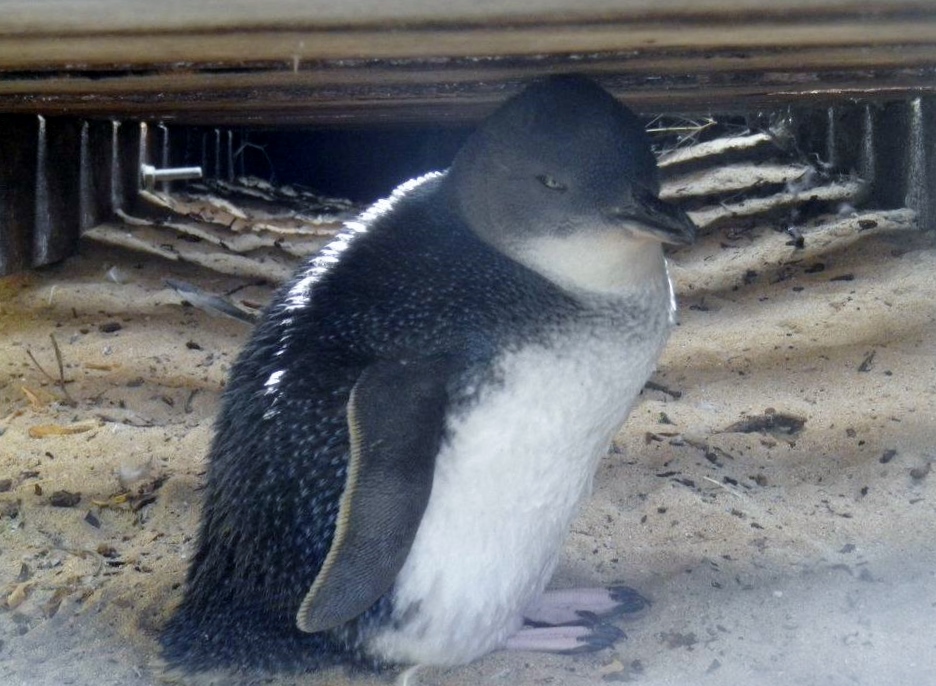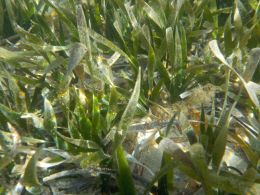Discussed on this page are some of the impacts and issues associated with the proposed development at Mangles Bay and Point Peron
- Habitat degradation of Little Penguins
- Destroying seagrass beds
- Mercury contamination hazard
- Sale of crown land – the land belongs to all of us
- Who pays for ongoing dredging – Ratepayers?
- Critically endangered thrombolites
- Issues of canal estates / marinas
Little Penguins
In an open letter to Minister Greg Hunt (19 Dec. 2014) concerns are raised that the impacts on the Little Penguins were not considered due to a decision taken on 27 October 2010 to exclude this federally protected marine species from the federal assessment process. 12 strong points are made in this letter why it is important to reconsider this decision.

Penguin Island, near Rockingham, is home to the largest Little Penguin colony in WA, which also has the highest conservation status of all major colonies in Australia. Why should we be concerned?
- Four times the average number of dead penguins where found from August to December 2011
- Most death were caused by watercraft and starvation
- Sandy sprat, their usual food source for raising chicks, was not found in their diet at all in 2011
- Fewer eggs and fewer offspring in 2011
- The breeding population has decreased from 1600 in 2007 to 1000 in 2011
One of the possible causes is the increased recreational use of the coastal marine habitat and increasing development along the coast which impacts on penguin behaviour and mortality.
Murdoch University 2012 Fears for Little Penguins as deaths spike
ABC catalyst, Belinda Cannell, Video on Little Penguins
ABC News: Perth’s little penguin colonies face an uncertain future due to climate change and coastal development. Save the little penguins.
Seagrass

WA’s leading expert in Seagrass research Dr Mike van Keulen from School of Biological Sciences & Biotechnology at Murdoch University was engaged jointly by the community groups Preserve Point Peron and Hands of Point Peron to undertake an independent review of the proposed Mangles Bay Marina Canal Estate.
Dr Mike van Keulen stated in his report that, “The Mangles Bay and Point Peron region is already highly disturbed and vulnerable to further impacts from development; the Mangles Bay Marina Based Tourism Precinct presents a significant risk to both marine and terrestrial environments. Mangles Bay is not suitable for a development of this nature, given the nature and extent of the environmental problems that would accompany it.”
Dr Mike van Keulen also said that, “The proponents are relying on the flawed seagrass shoot density report cards produced by the Cockburn Sound Management Council as a baseline reference for seagrass health estimates; it appears that shoot densities have fallen below 50% of the EQS on occasion and evidence suggests that falling to 25% may trigger a structural collapse of the meadow. The proposed access channel will bisect the existing seagrass meadow, compromising productivity, ecosystem functions that include sheltered nursery habitat, foraging grounds for larger marine fauna and sediment stability. Other impacts from the marina, including suspended sediments from construction, reduced quality water flowing out of the marina and disturbance from boat traffic are all expected to impact heavily on the already vulnerable seagrass”
Read the full report from Seagrass Expert Dr Mike van Keulen here.
Please review some of the following links and articles to provide more insight into the impact that the marina and Canal Development at Mangles Bay could have on this natural asset to the local region.
Zostera Sea Grass:
http://en.wikipedia.org/wiki/Zostera_marina
http://zostera.blogspot.com/2010/09/fishes-respond-poorly-to-seagrass-loss.html
Posidonia sea grass:
http://en.wikipedia.org/wiki/Posidonia_australis
Benefits of seagrass
The area in Mangles Bay is a natural and vibrant resouce area for seagrass which has following benefits
- Stabilisation of sand
- Preventing erosion
- Protection from tidal waves and storm surges
- Filtering and cleaning the water
- Preventing algal blooms
- Providing food and habitat for marine animals, birds and other sea plants
How will the seagrass area be affected by Mangles Bay Marina development?
- 80% of seagrass in Cockburn Sound has been lost through pollution since 1950s.
- The water quality and seagrass health in Mangles Bay are in trouble.
- Direct loss of 5.24 ha of seagrass area with more indirect loss through turbidity.
This document discusses the failure of seagrass replanting efforts experienced in NSW. Failure of Seagrass Planting in NSW (pdf)
This document discusses a form of conservation to protect seagrass in SA and the importance to maintaining protection of natural resources that are key to survival of a wealth of marine life. Protecting seagrass in SA (pdf)
Mercury Contamination Hazard
The proposed Mangles Bay Marina Project could elevate the mercury contamination hazard in at least two ways. Firstly the dredging program may release methyl-mercury into the water column causing a spike in contamination in fish and other marine life. Secondly, the settling organic matter in the dredged channel, and in the poorly-flushed, blind-ending canal development, is likely to further enhance the conditions for mecury methylation by bacteria in the long-term. This would present a threat to the commercial & recreational fisheries in Cockburn Sound and to the local aquaculture industry. Read more here
The full study ‘Seabird feathers as indicators of Mercury & Selenium contamination in the coastal waters of South Western Australia’ is available here
This Land Belongs to All of Us
The land that the WA Government proposes to take at Point Peron is crown land.
This land was transferred from the Commonwealth Government to the State of Western Australia on the 10thJanuary 1964 under the condition that the future use of the area was to be restricted to a reserve for recreation and/or parklands. Further, that when the leases for the area’s holiday camps have expired, that the entire area will become an “A” Class reserve. – Click here to view the 1964 transfer of land letter
Who Pays for the Ongoing Dredging – Ratepayers?
Want to pay even higher rates?
Did you know that the proponents for the private canal housing estate on Point Peron have asked the City of Rockingham to take on the responsibility of the Waterways management of their canal project? See more here.
Properties up to one kilometre away, to the East of project are at risk of having their bores dry up and trees die from the dewatering process that will be needed as part of building the canal development.
When the developers are gone, are the ratepayers going to be left to pay for the maintenance of the concrete seawalls along the canals and the ongoing dredging that will be required ‘forever’ due to the natural tendency for the Mangles Bay area to silt up?
And, if this such a viable project, why do ordinary taxpayers and ratepayers have to subsidise it by selling off our regional parklands to private investors for canal housing in order to pay for it?
Thrombolites
The critically endangered Thrombolites in Lake Richmond are threatened by canal development
Similar to Shark Bay, the microbial community that forms the limestone structures in Lake Richmond is a complex association of several species of bacteria and algae that remove minerals from the fresh water and build up new ‘rock’ material that form the thrombolites.
Lake Richmond contains the only known example of this type of critically endangered microbial community. The Lake Richmond thrombolites are a ‘living museum’ of the microbial communities which are the origins of life on earth! They date to the pre-Cambrian period 3.5 billion to 600 million years ago!!
The proposed canal development adjacent to the freshwater Lake Richmond will change the groundwater regime and threatens these living thrombolites. They risk being killed!
Please read the submission on the ‘Mangles Bay Marina based Tourist Precinct’ (Public environmental review) about the potential danger to the Thrombolites at Lake Richmond here.
The Urban Bushland Council WA Inc. is writing to voice serious concerns relating to the EPA Report 1471 and the recommendation to the Minister for Environment to approve the development. The Urban Bushland Council strongly opposes the excavation of a marina and canal estate at Point Peron that would result in the clearing of 40 ha of Bush Forever vegetation and alter the hydrology of Lake Richmond impacting upon the two endangered communities found there. Read the full report here
More information about the critically endangered thrombolites can be found at the Department of Environment.
Issues of Canal Estates / Marinas
Please read about the issues of the following Canal Estates proposed in Australia which did not proceed as a result of environmental assessment:
– Mauds Landing, Western Australia
Please read about the issues of the following Canal Estates (marinas) that have been constructed in Australia and have been associated with subsequent negative environmental impacts:
– Hope Island Resort Marina problems with poor water quality
– Marinas in Darwin Harbour are without efficient water flow which causes problems for marine invertebrates
– Yunderup Canal Estate with poor water quality, algal blooms and fish kills
– Development of Canal Estates on acid sulfate soil can lead to death of marine organisms / fish diseases
– Ballina Canal Estate layout has had at least four separate spates of fish death related to poor water flow
– Port Geographe with ongoing problems of erosion and seaweed build up.
